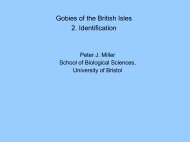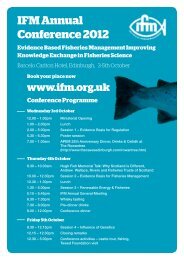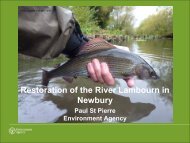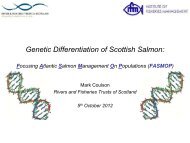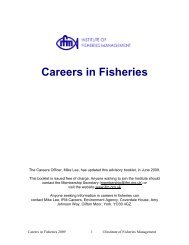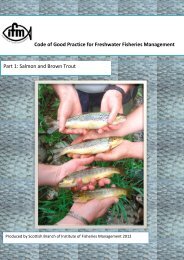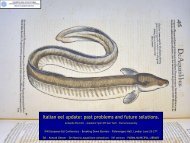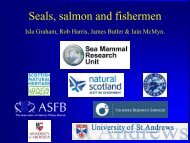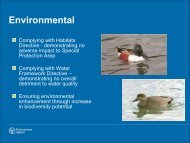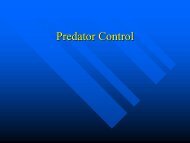You also want an ePaper? Increase the reach of your titles
YUMPU automatically turns print PDFs into web optimized ePapers that Google loves.
The current ecology of Solway shad<br />
and ongoing efforts to locate<br />
potential spawning areas<br />
Liz Etheridge
River Cree rare fish project<br />
• Action on eight species<br />
The Tubney Environmental Trust,<br />
The Esmée Fairbairn Foundation,<br />
GFT, SEPA, SNH, FCS, Scottish<br />
Government, SWEAT and Crown<br />
Estates.<br />
• Anadromous fishes<br />
– Freshwater pearl mussels<br />
– Sparling<br />
– Sea, river and brook lamprey<br />
– Atlantic salmon<br />
– Allis and twaite shad<br />
– Vulnerable to human impacts<br />
• Pollution<br />
• Barriers to migration<br />
• Migrations vulnerable to<br />
overfishing<br />
• May require several different<br />
habitats to complete lifecycle
Allis and Twaite shad<br />
• Two species of shad in UK<br />
– Overlap in many life history and<br />
taxonomic characters<br />
– Identified through counting gill<br />
rakers<br />
• Both found around the UK coast<br />
– Numbers of both species have<br />
declined<br />
– However, allis shad is rarer than<br />
twaite shad<br />
• Both species are protected in the<br />
UK<br />
• Spawning sites are known in<br />
Wales and England<br />
• Shad in scotland<br />
Firths of<br />
Tay and<br />
Forth<br />
Solway Firth<br />
– Have been reported for several<br />
years in the Solway Firth<br />
– Have also been reported in some<br />
east coast rivers<br />
• E.g. Tay, Forth and Tweed
Shad in the Solway<br />
• Have been regularly captured in the<br />
Solway Firth for many years<br />
– By-catch from salmon stake nets<br />
• Adult fish first collected and studied<br />
between 1989 and 1994<br />
– Peter Maitland during work on River<br />
Cree smelt<br />
• Capture of both species and a small<br />
number of hybrids<br />
– suggested that spawning might be<br />
taking place in the Cree or Bladnoch<br />
• From 2004 shad samples were<br />
again collected from stake nets<br />
in the Solway<br />
– Part of monitoring work for an<br />
offshore windfarm<br />
– Reward paid for each fish to<br />
enable maximum data<br />
collection
Spawning ground location<br />
• Important<br />
– Climate change is expanding the northerly range of many species<br />
– More northerly spawning areas need to be located in order to ensure protection<br />
• May become more important<br />
– Possible developments in the area<br />
• Solway Barrage has been suggested<br />
• More offshore wind farms<br />
• Not thought that these fish can be<br />
ascending far up the river<br />
– Both the Bladnoch and the Cree are<br />
fished recreationally for salmon<br />
– Both have weirs which might hold up<br />
migrating shad<br />
– Spawning shad relatively obvious?<br />
But no obvious spawning grounds!
Solway shad 2010<br />
• 86 shad were captured in 2010<br />
• From six netting stations<br />
– Cree, Fleet, Urr, Annan
Solway shad ecology 2010<br />
• Species identification<br />
• Gill raker number (GR)<br />
– 8 allis shad (104 - 127)<br />
– 74 twaite shad (36 - 47)<br />
– 4 hybrid shad (74 - 80)
• No significant difference in L f<br />
or W<br />
between groups<br />
• Allis shad has a faster growth rate<br />
than twaite shad<br />
• Sex ratio<br />
– Allis shad and hybrid catches<br />
dominated by males<br />
– Captured twaite shad were mostly<br />
female
Solway shad spawning 2010<br />
30<br />
hybrid<br />
N shad caught<br />
25<br />
20<br />
15<br />
10<br />
5<br />
0<br />
Twaite<br />
Allis<br />
Apr May Jun Jul Aug<br />
• Gonadosomatic index (GSI)<br />
– GSI = (W gonad x 100) / W total<br />
– GSI reduces over time<br />
• fish ripe to spent<br />
– Appear to suggest fish start spawning in<br />
June
• Ripe fish still present in July<br />
– By end of July all fish are spent
2010 spawning<br />
N shad caught<br />
50<br />
45<br />
40<br />
35<br />
30<br />
25<br />
20<br />
15<br />
10<br />
5<br />
0<br />
Cree<br />
hybrid<br />
Twaite<br />
Allis<br />
Urr<br />
Fleet<br />
Annan<br />
KB KD SC CN<br />
KB (N = 44)<br />
DH AY<br />
DH (N = 19)<br />
Site<br />
• Most shad captured – Kirkbride (KB) nets (Cree)<br />
– Douglas Hall (DH) nets (Urr)
Shad 1989 - 2010<br />
• 512 shad were captured in Solway<br />
• From seven netting areas
Solway shad 1989 - 2010<br />
120<br />
100<br />
Frequency<br />
80<br />
60<br />
40<br />
20<br />
0<br />
40 50 60 70 80 90 100 110 120 130<br />
Gill raker number<br />
• No significant difference in L f<br />
or W between groups<br />
• Sex ratio<br />
– All groups dominated by<br />
females<br />
100%<br />
• Species identification<br />
• Gill raker number (GR)<br />
– Allis shad > 90 GR<br />
– Twaite shad < 60 GR<br />
– Hybrid shad 60 to 90 GR<br />
80%<br />
60%<br />
40%<br />
20%<br />
0%<br />
Allis<br />
Twaite hybrid<br />
female<br />
male
Solway shad spawning<br />
N shad caught<br />
180<br />
160<br />
140<br />
120<br />
100<br />
80<br />
60<br />
40<br />
20<br />
hybrid<br />
Twaite<br />
Allis<br />
mean GSI<br />
14<br />
12<br />
10<br />
8<br />
6<br />
4<br />
Shad spawning<br />
in freshwater?<br />
0<br />
2<br />
Apr May Jun Jul Aug Sept<br />
0<br />
Apr May Jun 1 Jul<br />
Aug<br />
Sep<br />
• Gonadosomatic index (GSI)<br />
– GSI reduces over time, fish ripe to spent<br />
– Appear to suggest main spawning occurs in<br />
July
35<br />
allis<br />
Gonadosomic index<br />
30<br />
25<br />
20<br />
15<br />
10<br />
5<br />
Shad spawning<br />
in freshwater?<br />
hybrid<br />
twaite<br />
0<br />
0 10 20 30 40 50 60 70 80 90 100 110 120 130 140 150 160 170 180 190<br />
Days since 1st April<br />
• Gap apparent in July where shad are usually not captured<br />
• After this almost all are spent
Solway Shad spawning<br />
• Over the whole sampling period, two likely spawning<br />
areas are apparent<br />
–
160<br />
140<br />
120<br />
Cree<br />
Urr<br />
hybrid<br />
Twaite<br />
Allis<br />
N shad caught<br />
100<br />
80<br />
60<br />
40<br />
20<br />
Luce<br />
Fleet<br />
Annan<br />
0<br />
SH IW CT CS FL PL BH<br />
Site
Solway shad spawning<br />
• Fish capture in July, when spawning is believed to be taking place<br />
– Urr / Nith<br />
– Cree / Bladnoch<br />
• Shad captured in Wigtown Bay are<br />
most often sampled from the<br />
Carsluith nets (CS)<br />
– Opposite the entrance to the<br />
Bladnoch<br />
• Fish running up the Cree would be<br />
expected to be captured more<br />
frequently in the Creetown nets (CT)<br />
CT<br />
CS<br />
• Are shad more likely to be spawning<br />
in the Bladnoch?
Conclusions<br />
• Spawning sites and timing<br />
– The data collected in 2010 and drawn from<br />
previous studies from 1989 suggest<br />
– Considering capture patterns, spawning is<br />
likely to occur in mid July<br />
– There may be two main areas of shad<br />
spawning in the Solway<br />
• Urr<br />
• Bladnoch<br />
• Future work<br />
• Spawning locations now need to<br />
be narrowed down<br />
– Surveys of areas being planned<br />
– Possibility of using sonar?<br />
– Remote sensing?<br />
• Juvenile surveys<br />
– netting<br />
• One of the Urr nets has been<br />
releasing shad alive<br />
– Possibility of tagging individuals?<br />
– Don’t know condition
Thank you<br />
for your attention.<br />
Are there any questions?<br />
www.gallowayfisheriestrust.org






